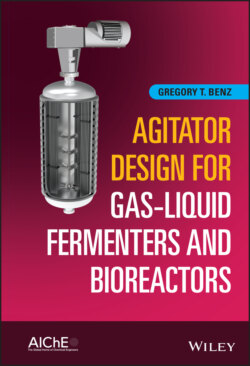Читать книгу Agitator Design for Gas-Liquid Fermenters and Bioreactors - Gregory T. Benz - Страница 13
Оглавление1 Purpose of Agitator Design
The purpose of using the agitator design principles in this book is to ensure, to the extent possible, that the user of agitation equipment achieves the process objectives and does so in a reliable and economical manner.
Agitators are employed in many different industries. The process results/objectives desired from the agitators vary by industry and by application within each industry. Since an agitator is ultimately nothing more than a kind of pump, and the agitated tank is essentially a deadheaded pump, it would be ideal if the objectives could be stated in purely physical terms, mostly related to flow and head. For example, some would describe agitation in terms of pumping capacity, characteristic fluid velocity [1], G‐value [2], or other physical terms.
Some process results correlate well with simple physical measurements of agitation. For example, the ability to overcome density differences or viscosity ratios correlates well with characteristic fluid velocities [1]. However, many other process objectives do not correlate well with such simple measures. Examples of process results that have complex relationships to agitation and do not correlate well with pumping capacity, fluid velocity, or other simple measures would include blend time, mass transfer rate, heat transfer rate, off‐bottom solids suspension, solids suspension degree of uniformity, solids suspension cloud height, rate of particle attrition or shear damage, dissolved oxygen spatial distribution, reaction rate, reaction product distribution, and many others.
Since this book is about agitator design for fermenters/bioreactors, we will focus on the attributes of agitator design most important for those applications. The most important process result is normally the mass transfer rate (MTR), often called the OTR, or oxygen transfer rate, when oxygen is the species being transferred. This is generally the dominant design requirement.
The mass transfer rate depends on more than just agitation, of course. It also depends on the airflow, the properties of the broth, the organism’s ability to absorb the transferred gas (OUR, or oxygen uptake rate for aerobic systems), and a host of other factors. The principle agitation parameter for a given system is the power invested under gassed conditions. Therefore, the principle purposes of agitator design in this book are enumerated below and expanded upon in subsequent chapters. In most chapters, we will describe results based on the gas being oxygen. Chapter 11 will delve into how to handle other gasses.
Provide sufficient power input to facilitate the required mass transfer rate. This will vary with tank geometry, scale of operation, pressure, temperature, allowable minimum dissolved gas concentration, and gas flowrate.
Use an impeller system designed to maximize fluid mixing and thereby minimize concentration gradients, while still dispersing gas.
Provide sufficient overall mixing. Usually, the agitation required to disperse gas is more than ample for other mixing requirements.
Optimization of power used. The same mass transfer rate can be achieved with different combinations of airflow and agitator power. The total power of agitator and compressor goes through a minimum. Ideally, the design should use that minimum unless other factors override this desire.
Optimization of capital cost. Within a certain design power, there is a range of acceptable agitator designs. But there can be differences in capital cost among different designs.
Optimization of total batch cycle energy costs. Since batch processes have different OTR requirements at different stages of the batch cycle, the power costs can be optimized at each stage, thereby minimizing total energy used per batch.
Optimization of total system economics. Tank geometry affects capital and energy costs of both the tank itself and the agitator
Assure the final design has the utmost in mechanical integrity. This includes the tank and the mounting arrangement. Historically, agitators for gas–liquid contacting have had higher mechanical failure rates than those used for simple liquid blending, yet the cost of downtime can be very high. We aim to remedy that by promoting design principles that lead to minimal downtime.
Choose vendors that not only build a good product, but can support it in the field.
References
1 1 Hicks, R.W., Morton, J.R., and Fenic, J.G. (1976). How to design agitators for desired process response. Chemical Engineering Magazine: 22–30.
2 2 Benz, G.T. (2007). The G‐value for agitator design: time to retire it? Chemical Engineering Progress 103: 43–47.
